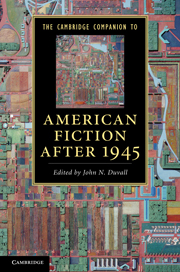Introduction: A story of the stories of American fiction after 1945
Published online by Cambridge University Press: 28 March 2012
Summary
This may well be the last volume ever to survey American fiction from 1945 to the present. That is not because scholarship on this body of narrative is waning. Far from it. There is a more pragmatic reason for my prediction: the period is getting a little long in the tooth. The Victorian Era will never exceed sixty-four years. Modernism is often dated from 1890 to 1945 (a solid fifty-six-year run), but the post-1945 period (which until recently we simply called “postmodernism”), if a person, could now be collecting Social Security. It is only a matter of time before the profession decides that, if for nothing more than curricular reasons (after all, there is only so much one can teach in a semester), we need to close off the postwar period in some definitive fashion. Certainly, no one in 2045 will be teaching a course in contemporary American fiction from 1945 to the present.
Not surprisingly, because the postwar period has been left openended for so long, there have been generational shifts, so that post-1945 fiction looks quite different now than for earlier critics. One of the earliest attempts to make sense of American fiction following World War II occurs in John Aldridge's After the Lost Generation (1951), which saw contemporary novelists falling short of the achievement of American modernist writers.
- Type
- Chapter
- Information
- Publisher: Cambridge University PressPrint publication year: 2011

